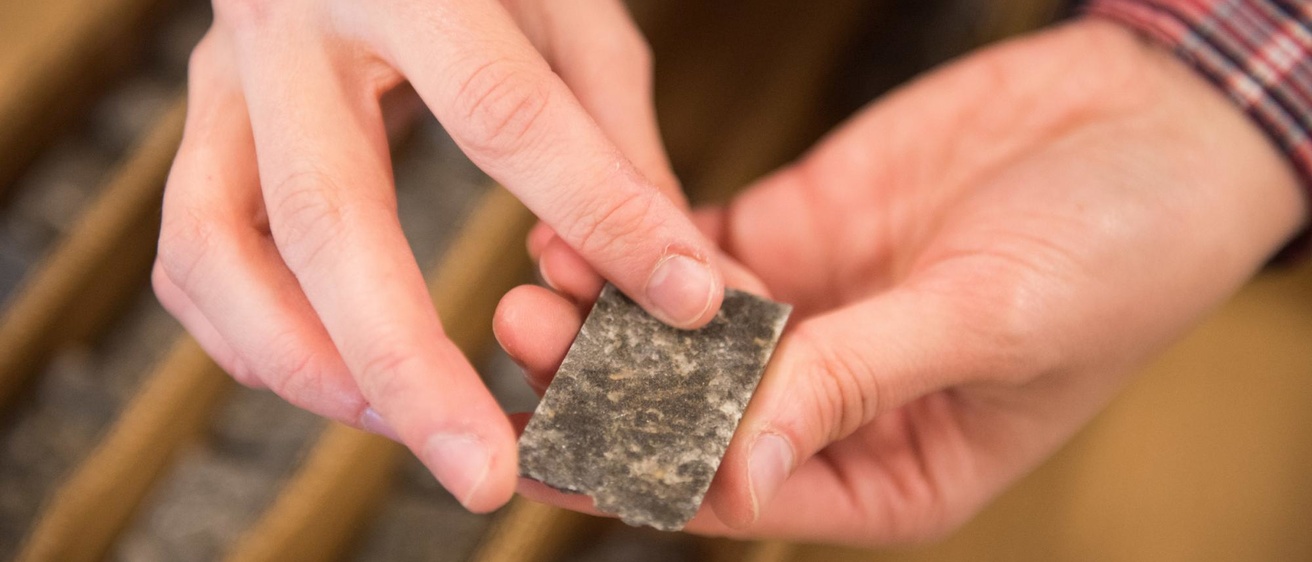A wealth of riches may lie below the hills of northeast Iowa.
University of Iowa geologists are leading an effort to determine the age of an underground formation that encompasses a 10-county region in northeast Iowa to determine if it is similar to a geologic complex beneath Duluth, Minnesota, that has minerals valued as high as $1 trillion. If the Northeast Iowa Formation is found to be roughly the same age as the Duluth Complex, it could mean the Iowa region harbors similar economically valuable deposits, such as copper, nickel, platinum, and other metals.
However, a final determination won’t be made until a second core is drilled in the region.
“If the Iowa formation is a similar age as the Duluth Complex, this is promising for having similar types of minerals,” says Ryan Clark, geologist with the Iowa Geological Survey (IGS), an agency housed at the UI.
The minerals matter because they’re used for industrial, medical, technological, and energy-generation purposes. Platinum and its associated metals are used in catalytic converters for vehicles and may have a potential use in hydrogen fuel cells. Lithium is commonly used in batteries that power a host of electronic devices.
Global demand for these minerals is increasing, straining existing known supplies. In response, the U.S. Geological Survey’s Mineral Resources Program has begun preparing a new national assessment of mineral resources in the United States. One area of particular interest is the Midcontinent Rift System, a formation that extends from Kansas to Michigan and is more than one billion years old. Within that stretch, the USGS is particularly interested in the northeast Iowa region, and in 2012 conducted the first airborne survey of the terrain around Decorah, which yielded a more detailed picture of the underlying geology, including the identification of the horseshoe-shaped Decorah Complex.
The Northeast Iowa Formation
Location: 10-county region in northeast Iowa
Why it’s important: The geologic formation may be similar to the Duluth Complex, an underground, geologic formation with minerals such as copper, nickel, and platinum valued as high as $1 trillion.
Next steps: Geologists would like to drill a second core to determine more precisely whether the formation is related to the Duluth Complex.
Who owns the rights to potential revenue? Most of the land is privately owned, so any company wanting to mine would need to negotiate with individual landowners, who would receive royalties. The state would benefit financially from the mining through taxes, fees, and other revenue streams.
The USGS conducted a second survey over a larger area that included Elkader, Manchester, and Vinton. That survey also showed geologic features such as rings and horseshoe shapes, which are similar to the Decorah formation and other complexes around the world that have economically valuable mineral deposits.
The surveys, though, did not date the Northeast Iowa Formation, and thus, were unable to verify whether it’s related to the Duluth Complex. So, the USGS asked the UI for help.
Since August, Allison Kusick, a UI junior and geology major from West Branch, Iowa, has spent each Tuesday at the IGS’s warehouse at the UI’s Oakdale Research Park to study a core drilled near Elkader by a mineral prospecting company in the 1960s. Under the direction of Earth and Environmental Sciences Department Professor David Peate, Kusick takes a segment of the nearly half-mile-long core and aims a series of beams from a portable X-ray fluorescence analyzer at it. The instrument nearly instantaneously produces a summary of the type and concentration of minerals in the area of the core illuminated by the X-ray.
The work is painstaking, Kusick says, but it has yielded results—better results than expected, in fact.
In a section of the core obtained between 2,412 feet and 2,416 feet below ground, Kusick found the mineral compound zirconium. Zirconium generally contains a mineral called baddeleyite, which can be used to date the rocks by calculating the decay of uranium trapped therein.
Kusick and Peate took the sample to the UI’s Electron Microprobe Laboratory, where a more in-depth analysis of the crystals produced another surprise: the presence of the mineral zirconolite.
The zirconolite also provided a precise method of dating, meaning the UI geologists had two reliable age-dating candidates for the core. The researchers will send the samples to a USGS facility in Colorado for the dating.
Kusick says it was exciting to be part of this moment of discovery.
“I think it’s cool,” says Kusick, whose work was funded by a U.S. National Science Foundation grant won by Earth and Environmental Sciences Department Associate Professor Bradley Cramer. “I’m learning a lot more not just about elements and minerals, but I’m learning about the instruments that geologists use every day. And, there could be an economic piece to this as well.”
Peate is excited because the surprise finding of zirconolite opens a new avenue of study for him. He wants to learn more about what happened to the rocks deep below the Earth’s surface that produced a rare assemblage of minerals one billion years ago.
“That’s what research is about,” Peate says. “You never know what you’re going to find.”
Clark says if the core drilled near Elkader is shown to be of the same age as the Duluth Complex, he would like to seek funding to drill a second core in the Northeast Iowa Formation.
“This could be a massive economic boon to the state,” he says.
